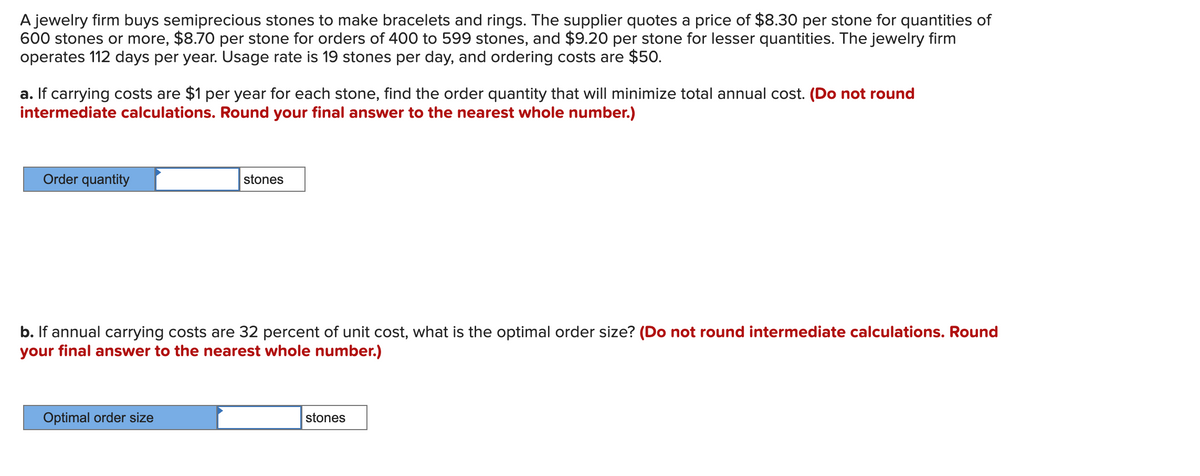A jewelry firm buys semiprecious stones to make bracelets and rings. The supplier quotes a price of $8.30 per stone for quantities of 600 stones or more, $8.70 per stone for orders of 400 to 599 stones, and $9.20 per stone for lesser quantities. The jewelry firm operates 112 days per year. Usage rate is 19 stones per day, and ordering costs are $50. a. If carrying costs are $1 per year for each stone, find the order quantity that will minimize total annual cost. (Do not round intermediate calculations. Round your final answer to the nearest whole number.) Order quantity stones b. If annual carrying costs are 32 percent of unit cost, what is the optimal order size? (Do not round intermediate calculations. Round your final answer to the nearest whole number.) Optimal order size stones
A jewelry firm buys semiprecious stones to make bracelets and rings. The supplier quotes a price of $8.30 per stone for quantities of 600 stones or more, $8.70 per stone for orders of 400 to 599 stones, and $9.20 per stone for lesser quantities. The jewelry firm operates 112 days per year. Usage rate is 19 stones per day, and ordering costs are $50. a. If carrying costs are $1 per year for each stone, find the order quantity that will minimize total annual cost. (Do not round intermediate calculations. Round your final answer to the nearest whole number.) Order quantity stones b. If annual carrying costs are 32 percent of unit cost, what is the optimal order size? (Do not round intermediate calculations. Round your final answer to the nearest whole number.) Optimal order size stones
Purchasing and Supply Chain Management
6th Edition
ISBN:9781285869681
Author:Robert M. Monczka, Robert B. Handfield, Larry C. Giunipero, James L. Patterson
Publisher:Robert M. Monczka, Robert B. Handfield, Larry C. Giunipero, James L. Patterson
Chapter16: Lean Supply Chain Management
Section: Chapter Questions
Problem 10DQ: The chapter presented various approaches for the control of inventory investment. Discuss three...
Related questions
Question

Transcribed Image Text:A jewelry firm buys semiprecious stones to make bracelets and rings. The supplier quotes a price of $8.30 per stone for quantities of
600 stones or more, $8.70 per stone for orders of 400 to 599 stones, and $9.20 per stone for lesser quantities. The jewelry firm
operates 112 days per year. Usage rate is 19 stones per day, and ordering costs are $50.
a. If carrying costs are $1 per year for each stone, find the order quantity that will minimize total annual cost. (Do not round
intermediate calculations. Round your final answer to the nearest whole number.)
Order quantity
stones
b. If annual carrying costs are 32 percent of unit cost, what is the optimal order size? (Do not round intermediate calculations. Round
your final answer to the nearest whole number.)
Optimal order size
stones

Transcribed Image Text:c. If lead time is 2 working days, at what point should the company reorder? (Do not round intermediate calculations. Round your
final answer to the nearest whole number.)
Reorder quantity
stones
Expert Solution
This question has been solved!
Explore an expertly crafted, step-by-step solution for a thorough understanding of key concepts.
This is a popular solution!
Trending now
This is a popular solution!
Step by step
Solved in 4 steps

Recommended textbooks for you

Purchasing and Supply Chain Management
Operations Management
ISBN:
9781285869681
Author:
Robert M. Monczka, Robert B. Handfield, Larry C. Giunipero, James L. Patterson
Publisher:
Cengage Learning

Purchasing and Supply Chain Management
Operations Management
ISBN:
9781285869681
Author:
Robert M. Monczka, Robert B. Handfield, Larry C. Giunipero, James L. Patterson
Publisher:
Cengage Learning